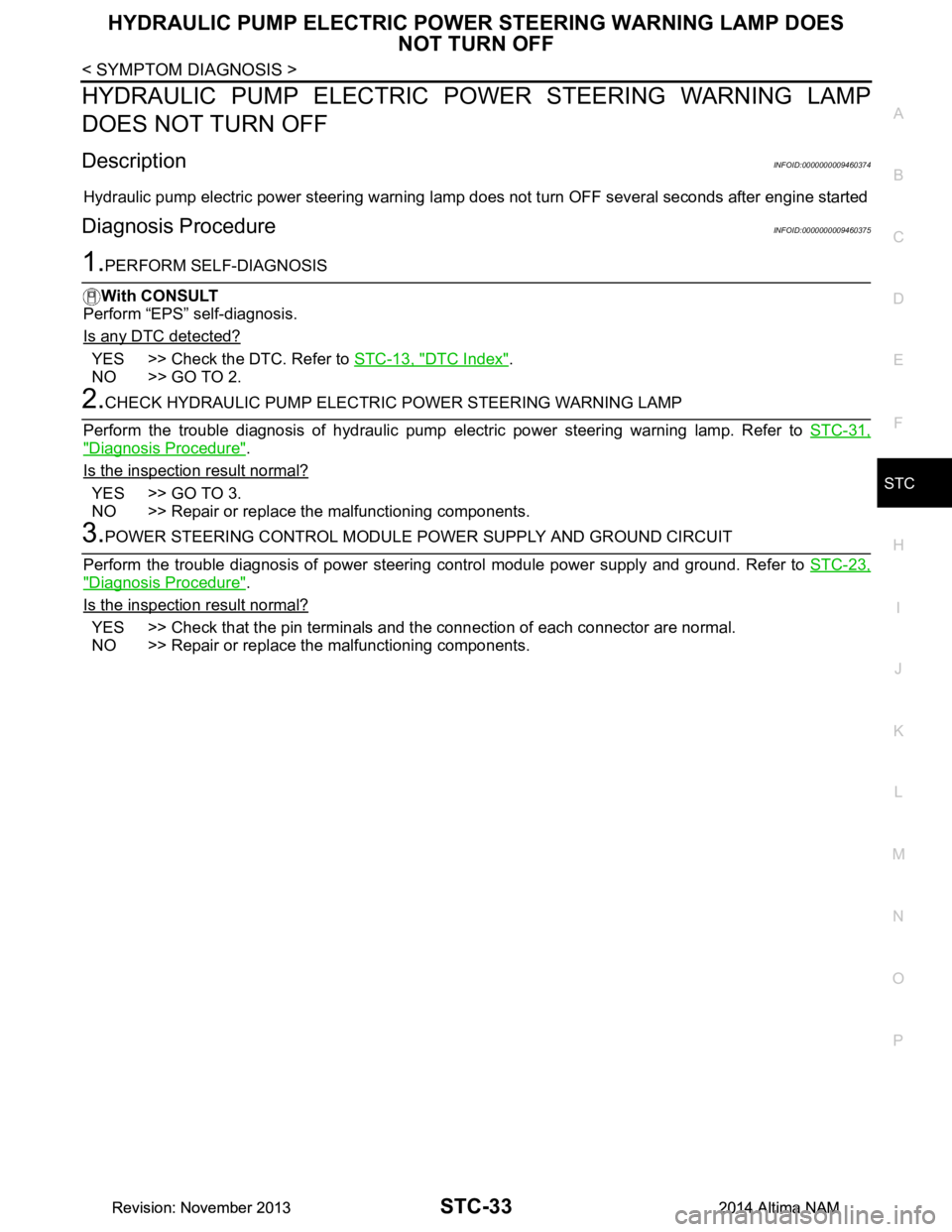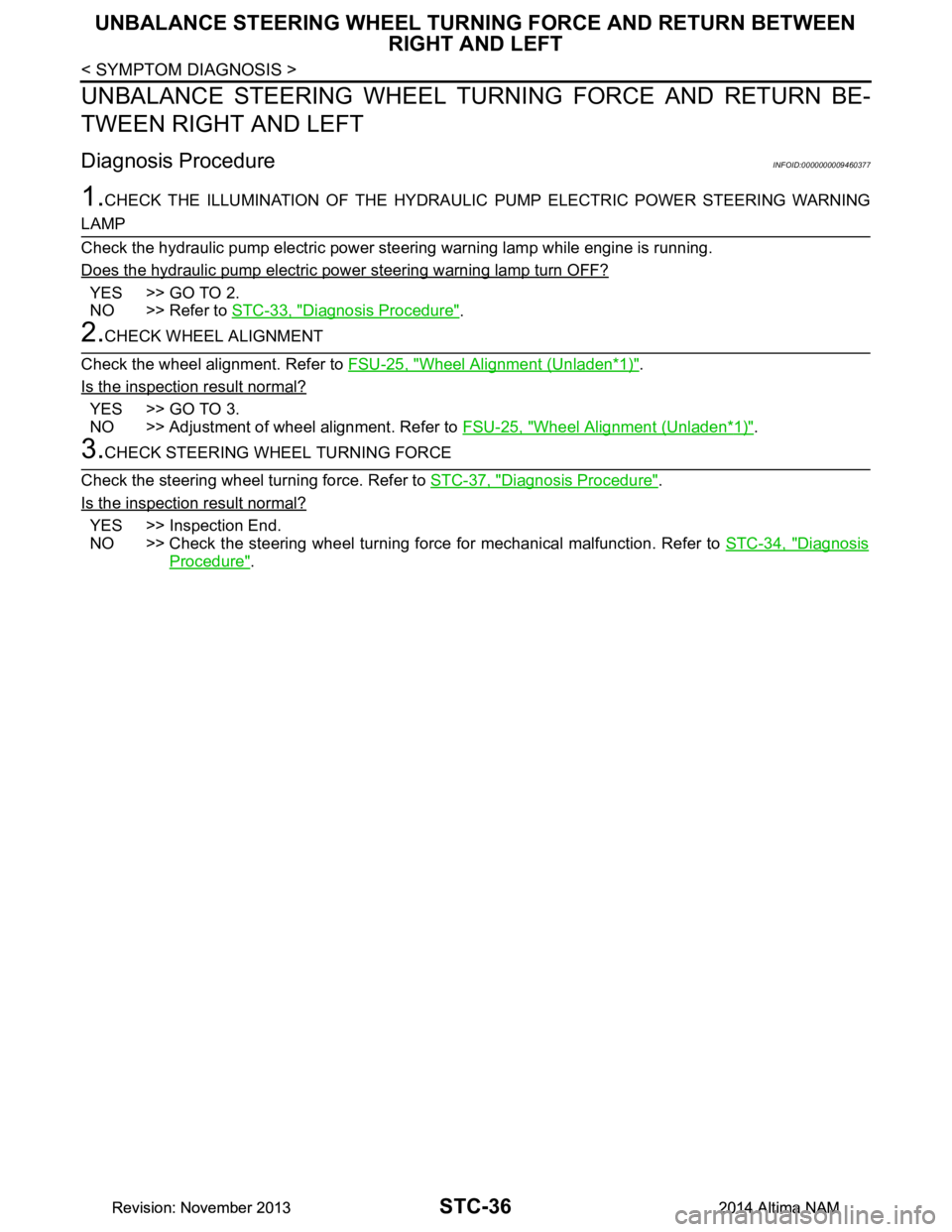2014 NISSAN TEANA warning
[x] Cancel search: warningPage 4184 of 4801

HYDRAULIC PUMP ELECTRIC POWER STEERING WARNING LAMP DOES
NOT TURN OFF
STC-33
< SYMPTOM DIAGNOSIS >
C
D E
F
H I
J
K L
M A
B
STC
N
O P
HYDRAULIC PUMP ELECTRIC POWER STEERING WARNING LAMP
DOES NOT TURN OFF
DescriptionINFOID:0000000009460374
Hydraulic pump electric power steering warning lamp does not turn OFF several seconds after engine started
Diagnosis ProcedureINFOID:0000000009460375
1.PERFORM SELF-DIAGNOSIS
With CONSULT
Perform “EPS” self-diagnosis.
Is any DTC detected?
YES >> Check the DTC. Refer to STC-13, "DTC Index".
NO >> GO TO 2.
2.CHECK HYDRAULIC PUMP ELECTRIC POWER STEERING WARNING LAMP
Perform the trouble diagnosis of hydraulic pump el ectric power steering warning lamp. Refer to STC-31,
"Diagnosis Procedure".
Is the inspection result normal?
YES >> GO TO 3.
NO >> Repair or replace the malfunctioning components.
3.POWER STEERING CONT ROL MODULE POWER SUPPLY AND GROUND CIRCUIT
Perform the trouble diagnosis of power steering control module power supply and ground. Refer to STC-23,
"Diagnosis Procedure".
Is the inspection result normal?
YES >> Check that the pin terminals and t he connection of each connector are normal.
NO >> Repair or replace the malfunctioning components.
Revision: November 20132014 Altima NAMRevision: November 20132014 Altima NAM
Page 4187 of 4801

STC-36
< SYMPTOM DIAGNOSIS >
UNBALANCE STEERING WHEEL TURNING FORCE AND RETURN BETWEEN
RIGHT AND LEFT
UNBALANCE STEERING WHEEL TU RNING FORCE AND RETURN BE-
TWEEN RIGHT AND LEFT
Diagnosis ProcedureINFOID:0000000009460377
1.CHECK THE ILLUMINATION OF THE HYDRAULIC PUMP ELECTRIC POWER STEERING WARNING
LAMP
Check the hydraulic pump electric power steering warning lamp while engine is running.
Does the hydraulic pump electric power steering warning lamp turn OFF?
YES >> GO TO 2.
NO >> Refer to STC-33, "Diagnosis Procedure"
.
2.CHECK WHEEL ALIGNMENT
Check the wheel alignment. Refer to FSU-25, "Wheel Alignment (Unladen*
1)".
Is the inspection result normal?
YES >> GO TO 3.
NO >> Adjustment of wheel alignment. Refer to FSU-25, "Wheel Alignment (Unladen*
1)".
3.CHECK STEERING WHEEL TURNING FORCE
Check the steering wheel turning force. Refer to STC-37, "Diagnosis Procedure"
.
Is the inspection result normal?
YES >> Inspection End.
NO >> Check the steering wheel turning force for mechanical malfunction. Refer to STC-34, "Diagnosis
Procedure".
Revision: November 20132014 Altima NAMRevision: November 20132014 Altima NAM
Page 4192 of 4801

STR-2
< PRECAUTION >
PRECAUTIONS
PRECAUTION
PRECAUTIONS
Precaution for Supplemental Restraint System (SRS) "AIR BAG" and "SEAT BELT
PRE-TENSIONER"
INFOID:0000000009951694
The Supplemental Restraint System such as “A IR BAG” and “SEAT BELT PRE-TENSIONER”, used along
with a front seat belt, helps to reduce the risk or severi ty of injury to the driver and front passenger for certain
types of collision. Information necessary to service the system safely is included in the SR and SB section of
this Service Manual.
WARNING:
• To avoid rendering the SRS inopera tive, which could increase the risk of personal injury or death in
the event of a collision which would result in air bag inflation, all maintenance must be performed by
an authorized NISS AN/INFINITI dealer.
• Improper maintenance, including in correct removal and installation of the SRS, can lead to personal
injury caused by unintent ional activation of the system. For re moval of Spiral Cable and Air Bag
Module, see the SR section.
• Do not use electrical test equipmen t on any circuit related to the SRS unless instructed to in this
Service Manual. SRS wiring harn esses can be identified by yellow and/or orange harnesses or har-
ness connectors.
PRECAUTIONS WHEN USING POWER TOOLS (AIR OR ELECTRIC) AND HAMMERS
WARNING:
• When working near the Airbag Diagnosis Sensor Unit or other Airbag System sensors with the Igni-
tion ON or engine running, DO NOT use air or electri c power tools or strike near the sensor(s) with a
hammer. Heavy vibration could activate the sensor( s) and deploy the air bag(s), possibly causing
serious injury.
• When using air or electric power tools or hammers , always switch the Ignition OFF, disconnect the
battery and wait at least three minutes before performing any service.
Revision: November 20132014 Altima NAMRevision: November 20132014 Altima NAM
Page 4224 of 4801
![NISSAN TEANA 2014 Service Manual
PRECAUTIONSTM-9
< PRECAUTION > [CVT: RE0F10D]
C
EF
G H
I
J
K L
M A
B
TM
N
O P
PRECAUTION
PRECAUTIONS
Precaution for Supplemental Restraint System (SRS) "AIR BAG" and "SEAT BELT
PRE-TENSIONER"
INFO NISSAN TEANA 2014 Service Manual
PRECAUTIONSTM-9
< PRECAUTION > [CVT: RE0F10D]
C
EF
G H
I
J
K L
M A
B
TM
N
O P
PRECAUTION
PRECAUTIONS
Precaution for Supplemental Restraint System (SRS) "AIR BAG" and "SEAT BELT
PRE-TENSIONER"
INFO](/manual-img/5/57390/w960_57390-4223.png)
PRECAUTIONSTM-9
< PRECAUTION > [CVT: RE0F10D]
C
EF
G H
I
J
K L
M A
B
TM
N
O P
PRECAUTION
PRECAUTIONS
Precaution for Supplemental Restraint System (SRS) "AIR BAG" and "SEAT BELT
PRE-TENSIONER"
INFOID:0000000009951696
The Supplemental Restraint System such as “A IR BAG” and “SEAT BELT PRE-TENSIONER”, used along
with a front seat belt, helps to reduce the risk or severi ty of injury to the driver and front passenger for certain
types of collision. Information necessary to service t he system safely is included in the SR and SB section of
this Service Manual.
WARNING:
• To avoid rendering the SRS inoper ative, which could increase the risk of personal injury or death in
the event of a collision which would result in air bag inflation, all maintenance must be performed by
an authorized NISSAN/INFINITI dealer.
• Improper maintenance, including in correct removal and installation of the SRS, can lead to personal
injury caused by unintentional act ivation of the system. For removal of Spiral Cable and Air Bag
Module, see the SR section.
• Do not use electrical test equipm ent on any circuit related to the SRS unless instructed to in this
Service Manual. SRS wiring harnesses can be identi fied by yellow and/or orange harnesses or har-
ness connectors.
PRECAUTIONS WHEN USING POWER TOOLS (AIR OR ELECTRIC) AND HAMMERS
WARNING:
• When working near the Airbag Diagnosis Sensor Un it or other Airbag System sensors with the Igni-
tion ON or engine running, DO NOT use air or el ectric power tools or strike near the sensor(s) with a
hammer. Heavy vibration could activate the sensor( s) and deploy the air bag(s), possibly causing
serious injury.
• When using air or electric power tools or hammers , always switch the Ignition OFF, disconnect the
battery and wait at least three mi nutes before performing any service.
Precaution for Procedure without Cowl Top CoverINFOID:0000000009463955
When performing the procedure after removing cowl top cover, cover
the lower end of windshield with urethane, etc to prevent damage to
windshield.
Precaution for TCM and Tran saxle Assembly ReplacementINFOID:0000000009463956
CAUTION:
• To replace TCM, refer to TM-80, "Description"
.
• To replace transaxle assembly, refer to TM-81, "Description"
.
PIIB3706J
Revision: November 20132014 Altima NAMRevision: November 20132014 Altima NAM
Page 4256 of 4801
![NISSAN TEANA 2014 Service Manual
DIAGNOSIS SYSTEM (TCM)TM-41
< SYSTEM DESCRIPTION > [CVT: RE0F10D]
C
EF
G H
I
J
K L
M A
B
TM
N
O P
DIAGNOSIS SYSTEM (TCM)
DIAGNOSIS DESCRIPTION
DIAGNOSIS DESCRIPTION : 1 Tr ip Detection Diagnosis and NISSAN TEANA 2014 Service Manual
DIAGNOSIS SYSTEM (TCM)TM-41
< SYSTEM DESCRIPTION > [CVT: RE0F10D]
C
EF
G H
I
J
K L
M A
B
TM
N
O P
DIAGNOSIS SYSTEM (TCM)
DIAGNOSIS DESCRIPTION
DIAGNOSIS DESCRIPTION : 1 Tr ip Detection Diagnosis and](/manual-img/5/57390/w960_57390-4255.png)
DIAGNOSIS SYSTEM (TCM)TM-41
< SYSTEM DESCRIPTION > [CVT: RE0F10D]
C
EF
G H
I
J
K L
M A
B
TM
N
O P
DIAGNOSIS SYSTEM (TCM)
DIAGNOSIS DESCRIPTION
DIAGNOSIS DESCRIPTION : 1 Tr ip Detection Diagnosis and 2 Trip Detection Diagno-
sis
INFOID:0000000009463996
NOTE:
“Start the engine and turn OFF the ignition switch after warm-up.” This is defined as 1 trip.
1 TRIP DETECTION DIAGNOSIS
When initial malfunction is detected, TCM memorize s DTC. In these diagnoses, some illuminate MIL and
some do not. Refer to TM-60, "DTC Index"
.
2 TRIP DETECTION DIAGNOSIS
When initial malfunction is detected, TCM memorizes DTC of the 1st trip. MIL does not light at this stage. <1
trip>
If the same malfunction is detected again in next drivi ng, TCM memorizes DTC. When DTC is memorized, MIL
lights. <2 trip>
“Trip” of the “2 trip detection diagnosis” indicates the driving mode that executes self-diagnosis during driving.
×: Check possible —: Check not possible
DIAGNOSIS DESCRIPTION : DTC and DTC of 1st TripINFOID:0000000009463997
2 TRIP DETECTION DIAGNOSIS THAT ILLUMINATES MIL
• The DTC number of the 1st trip is the same as the DTC number.
• When a malfunction is detected at the 1st trip, TCM memo rizes DTC of the 1st trip. MIL does not light at this
stage. If the same malfunction is not detected at t he 2nd trip (conforming to necessary driving conditions),
DTC at the 1st trip is erased from TCM. If the same malfunction is detected at the 2nd trip, TCM memorizes
DTC and MIL lights at the same time.
• The DTC of the 1st trip is specified in Service $01 of SAE J1979/ISO 15031-5. Since detection of DTC at the
1st trip does not illuminate MIL, warning for a problem is not given to a driver.
• For procedure to delete DTC and 1st trip DTC from TCM, refer to TM-43, "CONSULT Function"
.
• If DTC of the 1st trip is detected, it is necessary to check the cause according to the “Diagnosis flow”. Refer
to TM-77, "Flowchart of Trouble Diagnosis"
.
DIAGNOSIS DESCRIPTION : Malf unction Indicator Lamp (MIL)INFOID:0000000009463998
• TCM not only detects DTC, but also sends the MI L signal to ECM through CAN communication. ECM sends
the MIL signal to the combination meter through CAN communication according to the signal, and illumi-
nates MIL.
• For malfunction indicator lamp (MIL) description, refer to EC-74, "DIAGNOSIS DESCRIPTION : Malfunction
Indicator Lamp (MIL)".
DIAGNOSIS DESCRIPTION : Counter SystemINFOID:0000000009463999
RELATION BETWEEN DTC AT 1ST TRIP/DTC/MIL AND DRIVING CONDITIONS (FOR 2 TRIP DE-
TECTION DIAGNOSIS THAT ILLUMINATES MIL)
• When initial malfunction is detected, TCM memorizes DT C of the 1st trip. MIL does not light at this stage.
• If the same malfunction is detect ed at the 2nd trip, TCM memorizes DTC and MIL lights at the same time.
• Then, MIL goes after driving the vehicle for 3 tr ips under “Driving condition B” without malfunction.
• DTC is displayed until 40 trips of “Driving condition A” are satisfied without detecting the same malfunction.
DTC is erased when 40 trips are satisfied.
Item DTC at the 1st trip DTC MIL
Display at the 1st trip Display at the
2nd trip Display at the
1st trip Display at the
2nd trip Illumination at
the 1st trip Illumination at
the 2nd trip
1 trip detection diagnosis
(Refer to TM-60, "DTC Index"
) ——
×— ×—
2 trip detection diagnosis
(Refer to TM-60, "DTC Index"
) ×
—— ×— ×
Revision: November 20132014 Altima NAMRevision: November 20132014 Altima NAM
Page 4262 of 4801
![NISSAN TEANA 2014 Service Manual
DIAGNOSIS SYSTEM (TCM)TM-47
< SYSTEM DESCRIPTION > [CVT: RE0F10D]
C
EF
G H
I
J
K L
M A
B
TM
N
O P
ECO MODE SW* (On/Off) ××Displays the reception status of the ECO mode switch
signal received thr NISSAN TEANA 2014 Service Manual
DIAGNOSIS SYSTEM (TCM)TM-47
< SYSTEM DESCRIPTION > [CVT: RE0F10D]
C
EF
G H
I
J
K L
M A
B
TM
N
O P
ECO MODE SW* (On/Off) ××Displays the reception status of the ECO mode switch
signal received thr](/manual-img/5/57390/w960_57390-4261.png)
DIAGNOSIS SYSTEM (TCM)TM-47
< SYSTEM DESCRIPTION > [CVT: RE0F10D]
C
EF
G H
I
J
K L
M A
B
TM
N
O P
ECO MODE SW* (On/Off) ××Displays the reception status of the ECO mode switch
signal received through CAN communication.
STRDWNSW* (On/Off) ×Displays the operation status of the paddle shifter (down
switch).
STRUPSW* (On/Off) ×Displays the operation status of the paddle shifter (up
switch).
DOWNLVR* (On/Off) ×Displays the operation status of the selector lever (down
switch).
UPLVR* (On/Off) ×Displays the operation status of the selector lever (up
switch).
NONMMODE* (On/Off) ×Displays if the selector lever position is not at the manual
shift gate.
MMODE* (On/Off) ×Displays if the selector lever position is at the manual
shift gate.
TOW MODE SW* (On/Off) ×Displays the reception status of the TOW mode switch
signal received through CAN communication.
SHIFT IND SIGNAL Displays the transaxle value of shift position signal trans-
mitted via CAN communication.
CVT LAMP* (On/Off) Displays the transaxle status of the CVT warning lamp
signal transmitted through CAN communication.
SPORT MODE IND (On/Off) Displays the transaxle status of the O/D OFF indicator
lamp signal transmitted through CAN communication.
MANU MODE SIGNAL* (On/Off) Displays the transaxle status of the manual mode signal
transmitted through CAN communication.
DS RANGE SIGNAL (On/Off) Displays the shift position signal status from transmis-
sion range switch (DS position).
ECO MODE SIGNAL* (On/Off) Displays the transaxle status of the ECO mode signal
transmitted through CAN communication.
VDC ON (On/Off) ×Displays the reception status of the VDC operation signal
received through CAN communication.
TCS ON (On/Off) ×Displays the reception status of the TCS operation signal
received through CAN communication.
ABS FAIL SIGNAL (On/Off) ×Displays the reception status of the ABS malfunction sig-
nal received through CAN communication.
ABS ON (On/Off) ×Displays the reception status of the ABS operation signal
received through CAN communication.
RANGE ×Displays the gear position recognized by TCM.
M GEAR POS* ×Display the target gear of manual mode
G SEN SLOPE* (%) Displays the gradient angle calculated from the G sensor
signal voltage.
G SEN CALIBRATION* (YET/DONE) Displays the status of “G
SENSOR CALIBRATION” in
“Work Support”.
N IDLE STATUS* (On/Off) Displays idle neutral status.
ENGBRKLVL (On/Off) Displays the
setting of “ENGINE BRAKE ADJ” in “Work
Support”.
DRIVE MODE STATS* Displays the drive mode status recognized by TCM.
SNOW MODE* (On/Off) Displays whether it is the SNOW mode.
ECO MODE* (On/Off) Displays whether it is the ECO mode. Monitored item (Unit)
Monitor item selection
Remarks
ECU IN-
PUT SIG-
NALS MAIN SIG-
NALS
Revision: November 20132014 Altima NAMRevision: November 20132014 Altima NAM
Page 4414 of 4801
![NISSAN TEANA 2014 Service Manual
CVT OIL WARMER SYSTEMTM-199
< REMOVAL AND INSTALLATION > [CVT: RE0F10D]
C
EF
G H
I
J
K L
M A
B
TM
N
O P
CVT OIL WARMER SYSTEM
WATER HOSE
WATER HOSE : Exploded ViewINFOID:0000000009464145
WATER HOSE NISSAN TEANA 2014 Service Manual
CVT OIL WARMER SYSTEMTM-199
< REMOVAL AND INSTALLATION > [CVT: RE0F10D]
C
EF
G H
I
J
K L
M A
B
TM
N
O P
CVT OIL WARMER SYSTEM
WATER HOSE
WATER HOSE : Exploded ViewINFOID:0000000009464145
WATER HOSE](/manual-img/5/57390/w960_57390-4413.png)
CVT OIL WARMER SYSTEMTM-199
< REMOVAL AND INSTALLATION > [CVT: RE0F10D]
C
EF
G H
I
J
K L
M A
B
TM
N
O P
CVT OIL WARMER SYSTEM
WATER HOSE
WATER HOSE : Exploded ViewINFOID:0000000009464145
WATER HOSE : Removal and InstallationINFOID:0000000009464146
REMOVAL
WARNING:
Do not remove the radiator cap when the engine is hot. Serious burns could occur from high pressure
coolant escaping from the radiator. Wrap a thick cloth around the cap. Slowly turn it a quarter turn to
allow built-up pressure to escap e. Carefully remove the cap by turning it all the way.
CAUTION:
Perform when the engine is cold.
NOTE:
When removing components such as hoses, tubes/lines, etc. , cap or plug openings to prevent fluid from spill-
ing.
1. Remove front under cover. Refer to EXT-28, "Removal and Installation"
.
Hose clamp CVT water hose A CVT oil warmer
CVT water hose B Heater thermostat CVT water hose C
Transaxle assembly
Water outlet
: Always replace after every disassembly.
: N·m (kg-m, ft-lb)
JSDIA3627GB
Revision: November 20132014 Altima NAMRevision: November 20132014 Altima NAM
Page 4418 of 4801
![NISSAN TEANA 2014 Service Manual
CVT OIL WARMER SYSTEMTM-203
< REMOVAL AND INSTALLATION > [CVT: RE0F10D]
C
EF
G H
I
J
K L
M A
B
TM
N
O P
• The illustrations indicate the view from the hose ends.
• When installing hose clamps, NISSAN TEANA 2014 Service Manual
CVT OIL WARMER SYSTEMTM-203
< REMOVAL AND INSTALLATION > [CVT: RE0F10D]
C
EF
G H
I
J
K L
M A
B
TM
N
O P
• The illustrations indicate the view from the hose ends.
• When installing hose clamps,](/manual-img/5/57390/w960_57390-4417.png)
CVT OIL WARMER SYSTEMTM-203
< REMOVAL AND INSTALLATION > [CVT: RE0F10D]
C
EF
G H
I
J
K L
M A
B
TM
N
O P
• The illustrations indicate the view from the hose ends.
• When installing hose clamps, the center line of each clamp tab should be positioned as shown.
CVT FLUID COOLER HOSE : InspectionINFOID:0000000009464150
INSPECTION AFTER INSTALLATION
Check for CVT fluid leakage and check CVT fluid level. Refer to TM-178, "Inspection".
CVT OIL WARMER
CVT OIL WARMER : Exploded ViewINFOID:0000000009464151
CVT OIL WARMER : Removal and InstallationINFOID:0000000009464152
REMOVAL
WARNING:
Do not remove the radiator cap when the engine is hot. Serious burns could occur from high pressure
coolant escaping from the radiator. Wrap a thick cloth around the cap. Slowly turn it a quarter turn to
allow built-up pressure to escap e. Carefully remove the cap by turning it all the way.
CAUTION:
Perform when the engine is cold.
1. Remove front under cover. Refer to EXT-28, "Removal and Installation"
.
2. Remove CVT water hose inlet and CVT water hose outlet from CVT oil warmer. Refer to TM-199,
"WATER HOSE : Exploded View".
3. Remove CVT fluid cooler hose inlet and CVT fluid cooler hose outlet from CVT oil warmer. Refer to TM-
201, "CVT FLUID COOLER HOSE : Exploded View".
(C): Front
ALDIA0366ZZ
Transaxle assembly CVT oil warmer
: N·m (kg-m, ft-lb)
JSDIA5031GB
Revision: November 20132014 Altima NAMRevision: November 20132014 Altima NAM